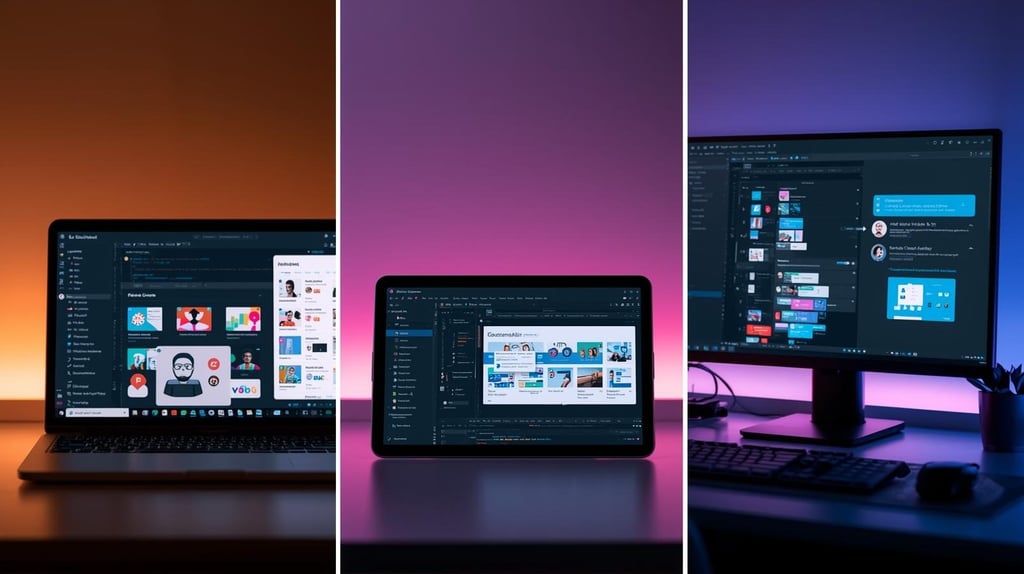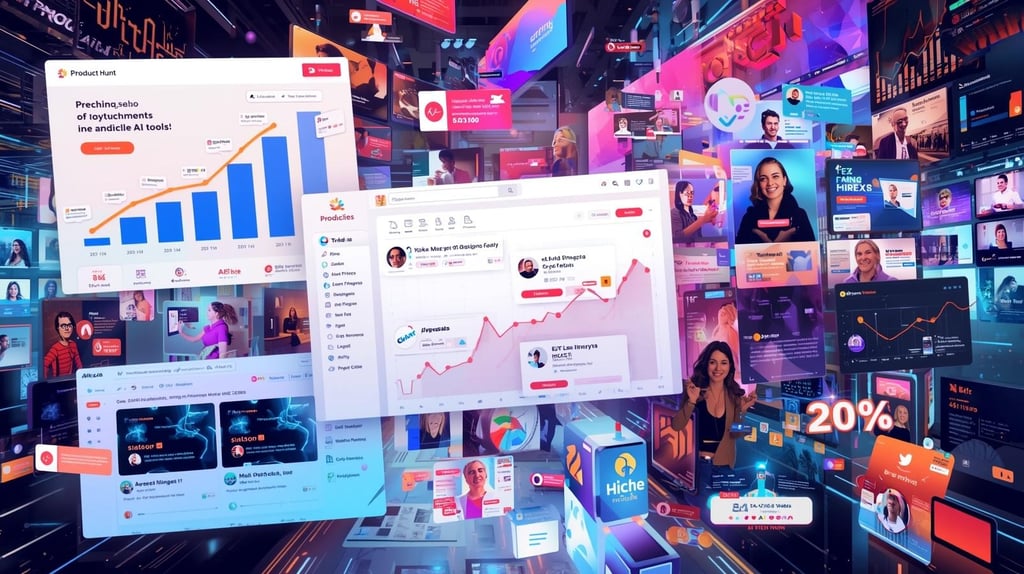Stop Scrolling, Start Creating ⚡ Visit Our Digital Store Now!
How to Build and Launch AI Tools in Hours Without Coding Experience (Complete Guide)
The digital revolution is here. Learn to build and launch AI tools in hours without coding experience using next-generation no-code AI platforms. Discover the massive market opportunity for citizen developers and quickly turn your ideas into high-value applications. Join the boom today!
DIGITAL MARKETINGMAKE MONEY ONLINEAIONLINE BUSINESS IDEAS
Eddy Enoma
10/1/20259 min read
The Non-Coder’s Guide to Vibe Coding: The Next $900 Billion Opportunity
The days of needing a computer science degree to build software are officially over. With the AI market currently valued at over $390 billion as of late 2025 and projected to surge past the $900 billion mark by 2026, a growth rate nearly five times over five years, there has never been a better time to jump into AI tool development. The secret weapon is the rise of next-generation, intuitive platforms, often dubbed ‘vibe coding’ or ‘agentic’ builders, that let anyone transform ideas into working applications in a matter of hours.
Think about it this way: customers don’t wait around for solutions to their problems. To stay ahead, you need to be both fast and genuinely helpful. The good news? The tools are already here to make that possible every hour of the day. This is the complete guide on how to build and launch AI tools in hours without coding experience.
The AI Gold Rush Is Real (And You’re Not Too Late)
Here’s something that might surprise you: venture capital investment in the AI sector has exploded, with nearly $90 billion of the U.S. total funding in the first half of 2025 alone going to AI startups. This concentration of capital underscores a single truth: the industry is betting its future on AI innovation. But here’s the twist that most people miss. Nearly 60% of all custom applications are now built by employees outside the IT department, with 30% of them created by complete beginners, the so-called “citizen developers.”
The no-code/low-code development market itself has matured, with its cloud deployments now accounting for over 75% of platform revenue by late 2025, and platforms projected to power 75% of all new applications by 2026. Platforms like Lovable, Base44, and the recently mega-funded Emergent are making it possible for anyone to participate in this boom.
What we’re seeing is a fundamental shift. Traditional software development used to take months or even years. Now, with vibe coding, you can literally build, test, and launch an AI tool before your competitors even finish their planning meetings.
Step 1: Discover What People Actually Want (The Google Autocomplete Hack)
Most people get this backwards. They build something they think is cool, then try to find customers. Smart builders do the opposite. They find proven demand first, then build exactly what people are already searching for.
Here’s your research goldmine: Open Google and type “AI tool for” but don’t press enter. Just watch those autocomplete suggestions appear. Each one represents thousands of real searches from real people with real problems they need solved.
When I tried this recently, I saw everything from “AI tool for resume writing” to “AI tool for small businesses” and “AI tool for real estate agents.” These aren’t random suggestions. They’re market research handed to you on a silver platter.
The beauty of this approach is that you’re not guessing about market demand. You’re building solutions for problems people are actively trying to solve right now. Pick one that genuinely interests you because you’ll be thinking about it for the next few weeks.
Want to take this research even further? Tools like Mangools (KWFinder) can help you analyze search volumes and competition levels for these keywords, giving you data-driven insights into which niches offer the best opportunities.
Step 2: Generate Your Perfect Build Prompt (Let AI Help You Build AI)
This is where most people stumble. They know what they want to build, but they don’t know how to communicate it effectively to a vibe coding platform. The solution? Use AI to create better prompts for AI development.
Open ChatGPT and give it this exact instruction:
“Please generate me a prompt that I can use for Emergence, Base44, or Lovable to vibe code an app that is AI for [insert your chosen niche].”
What happens next is pretty remarkable. ChatGPT will analyze your niche and generate a comprehensive, structured prompt that includes technical specifications, user interface requirements, and functionality details. This removes all the guesswork and gives you a blueprint that vibe coding platforms can actually work with.
For example, if you chose “AI tool for resume writing,” ChatGPT might generate a prompt that includes specifications for resume templates, ATS optimization features, skill suggestions, and even integration requirements with job boards.
The key here is specificity. The more detailed your generated prompt, the better your final product will be. Don’t settle for generic responses. Ask ChatGPT to include specific features, user flows, and even technical requirements.
Step 3: Choose Your Vibe Coding Platform and Build Your MVP
Now comes the exciting part. You’ve got your validated idea and your detailed prompt. Time to turn it into reality.
The AI code tools market is projected to be worth $27.17 billion by 2032, and the platforms leading this revolution each have their own strengths:
Emergent caters to users who want more control over the technical aspects without getting overwhelmed by code. It strikes a nice balance between simplicity and functionality, making it ideal for builders who want professional results with intuitive tools.
Lovable excels at user-friendly interfaces and is perfect for non-technical builders. It’s like having a designer and developer rolled into one AI assistant. The platform focuses heavily on creating polished, professional-looking applications that users actually want to interact with.
Base44 offers streamlined AI app building with built-in monetization features. If you’re thinking about revenue from day one, this platform makes it easy to integrate payment systems and subscription models directly into your tool.
Here’s what typically happens when you paste your generated prompt into one of these platforms: within minutes, you’ll see a working prototype of your AI tool. Not a mockup or a concept, but something you can actually click through and test.
The development process that used to take development teams weeks now happens in real-time. You can see your idea taking shape, make adjustments on the fly, and iterate rapidly based on what works and what doesn’t.
Step 4: Deploy and Establish Your Digital Presence
The low-code development platform market is projected to grow from $37.39 billion in 2025 to $264.40 billion by 2032, which means getting your tool online and visible is more important than ever.
Most vibe coding platforms make deployment surprisingly simple. Usually, it’s literally a one-click process that takes your tool from development environment to live website. But deployment is just the beginning of your online presence strategy.
Your domain name becomes your digital real estate. Instead of settling for generic names, choose something that immediately communicates what your tool does. If you built an AI resume tool, grab something like resumeai.app or careerboost.tools. These descriptive domains do half your marketing work for you.
Don’t overlook the power of a simple landing page. Tools like Gamma can help you create professional presentations and landing pages that convert visitors into users. Your tool might be amazing, but if people can’t understand what it does within 10 seconds of landing on your site, you’ve lost them.
Consider setting up basic analytics from day one. Understanding how people interact with your tool gives you invaluable insights for improvements and future features. Even simple metrics like time spent on different pages can guide your development priorities.
Step 5: Get Users and Generate Buzz
Building your tool is just the beginning. Now you need to get it in front of people who will actually use it and hopefully pay for it.
Product Hunt remains the gold standard for launching new tools. The platform attracts early adopters, tech enthusiasts, and potential customers who are specifically looking for innovative solutions. A successful Product Hunt launch can generate thousands of visitors in a single day.
But don’t put all your eggs in the Product Hunt basket. AI tool directories are multiplying rapidly, and many of them have dedicated user bases actively searching for solutions. Sites like There’s an AI for that have become go-to resources for people discovering new AI tools.
Social media strategy doesn’t have to be complicated, but it does need to be consistent. Share behind-the-scenes content about your building process, demonstrate your tool solving real problems, and engage with communities related to your niche. Tools like Predis AI can help automate your social media content creation while keeping your messaging on-brand.
The key is diversification. The more places your tool appears online, the higher your chances of finding your ideal users. Some will discover you through directories, others through social media, and some through word-of-mouth recommendations.
The Multiplication Effect: Scale Your Success
Here’s where this strategy gets really interesting. 78% of organizations now use AI in at least one business function, up from just 55% a year earlier. This massive adoption means the market for AI tools is expanding faster than most people can keep up with.
Once you’ve successfully launched your first tool, you have something most entrepreneurs lack: proven experience with the entire process. You understand what works, what doesn’t, and how to avoid the common pitfalls that trip up first-time builders.
This is where the multiplication effect kicks in. Your second tool will be faster to build because you already know the platforms. It’ll be easier to market because you understand which channels work. And it’ll be more likely to succeed because you’ve learned from real user feedback.
Some builders I know have launched multiple AI tools targeting different niches, creating diverse revenue streams. Others double down on their successful tool, adding features and expanding into adjacent markets.
The choice is yours, but the important thing is that you have choices. Each successful launch increases your options and your earning potential.
Essential Tools to Support Your Journey
While vibe coding platforms handle the heavy lifting of development, several complementary tools can accelerate your success:
For Content Creation: Jenni AI can help you write compelling descriptions, blog posts, and marketing materials for your AI tools.
For Customer Communication: Tidio provides AI-powered chat support that can handle user questions while you focus on development.
For Visual Content: Tools like Canva make it easy to create professional graphics, while Play.HT can generate voice content for demos and tutorials.
For Email Marketing: Once you start getting users, GetResponse can help you stay connected with them through newsletters and product updates.
The Bottom Line: Your AI Tool Empire Starts Now
We’re living through a unique moment in history. The barriers to software creation have never been lower, while demand for AI solutions has never been higher. The low-code/no-code market could reach $50 billion in value by 2028, and vibe coding platforms are leading this transformation.
The five-step process outlined here isn’t just a hack or a clever shortcut. It’s a legitimate business strategy that’s already helping people build profitable AI tools without traditional development skills. The key is getting started before everyone else catches on to how accessible this has become.
Your first tool might not become the next ChatGPT, but it doesn’t need to. It just needs to solve a real problem for real people, and the vibe coding platforms make that entirely achievable.
The question isn’t whether you can build an AI tool. The question is which problem you’ll solve first and how quickly you’ll get started. The market is waiting, the tools are ready, and your first users are out there searching for exactly what you’re about to build.
Ready to start building your AI tool empire?
Choose the platform that best fits your style and take the final step:
Emergent: For builders who want professional, full-stack results with granular control over technical features.
Lovable: For the non-technical entrepreneur who needs the fastest, most user-friendly way to create beautiful, polished apps.
Base44: For business-focused creation with built-in, streamlined monetization and revenue features.
Your AI tool empire starts with a single build. Go claim your platform now!
Related Reads
For a complete breakdown of the AI no-code platforms and other tools mentioned in this guide, read the full reviews here:
Emergent AI No-Code Platform Review: Build Full-Stack Apps Without Coding
Base44: No-Code App Development with AI (No Coding Required)
Lovable: The AI-Powered Platform That Builds Apps in Minutes
Gamma AI Presentation Tool: Why 250 Million Users Ditched PowerPoint
Predis AI Review: Supercharge Your Social Media Game with AI
How to Create a Chatbot for Your Website: A Step-by-Step Guide
Mastering GetResponse: A Beginner's Guide to Email Marketing, Automation, and Boosting Sales
Unlock Exclusive Insights
Join our community for timely updates, expert analysis, and valuable content delivered straight to your inbox. No spam, just substance.
Subscribe for Exclusive Tips & Updates. Enter Your Email Below!



Get the latest strategies on content creation, freelancing, and affiliate marketing, plus passive income straight to your inbox!
🔒 We respect your privacy. Your email is safe with us. Unsubscribe anytime.
Address
Sporerweg 16
94234 Viechtach, Germany
Contacts Us
(049) 170 499 6273
Subscribe to our newsletter
© 2025 Onlinebizoffers. All rights reserved.










